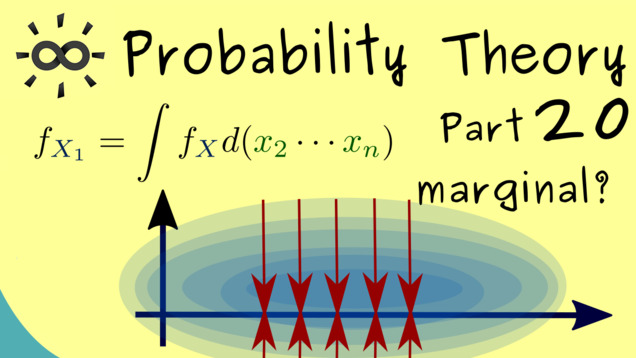
-
Title: Marginal Distributions
-
Series: Probability Theory
-
YouTube-Title: Probability Theory 20 | Marginal Distributions
-
Bright video: https://youtu.be/wJf1mJoxZk8
-
Dark video: https://youtu.be/u6YuSebR82g
-
Ad-free video: Watch Vimeo video
-
Quiz: Test your knowledge
-
Dark-PDF: Download PDF version of the dark video
-
Print-PDF: Download printable PDF version
-
Thumbnail (bright): Download PNG
-
Thumbnail (dark): Download PNG
-
Subtitle on GitHub: pt20_sub_eng.srt missing
-
Timestamps (n/a)
-
Subtitle in English (n/a)
-
Quiz Content
Q1: Let $X : \Omega \rightarrow \mathbb{R}^2 $ be a random vector which is uniformly distributed on the unit square $[0,1] \times [0,1]$. What is the correct marginal probability density function?
A1: $$ f_{X_1}(t) = \begin{cases} 1 &\text{ for } t \in [0,1] \ 0 &\text{ else } \end{cases} $$
A2: $$ f_{X_1}(t) = \begin{cases} 1 - t &\text{ for } t \in [0,1] \ 0 &\text{ else } \end{cases} $$
A3: $$ f_{X_1}(t) = \begin{cases} t^2 &\text{ for } t \in [0,1] \ 0 &\text{ else } \end{cases} $$
A4: $$ f_{X_1}(t) = \begin{cases} 1+t &\text{ for } t \in [0,1] \ 0 &\text{ else } \end{cases} $$
Q2: Let $X : \Omega \rightarrow \mathbb{R}^2 $ be a random vector with components $X_1: \Omega \rightarrow \mathbb{R}$ and $X_2: \Omega \rightarrow \mathbb{R}$. If $X_1$ and $X_2$ are (absolutely) continuous random variables, what is a correct implication for the marginal density functions?
A1: $$ f_{X}(s,t) = f_{X_1}(s) f_{X_2}(t) $$ for all $s,t$ implies that $X_1$ and $X_2$ are independent.
A2: $$ f_{X}(s,t) = f_{X_1}(s) + f_{X_2}(t) $$ for all $s,t$ implies that $X_1$ and $X_2$ are independent.
A3: $$ f_{X}(s,t) = f_{X_1}(s) f_{X_2}(t) $$ for all $s,t$ implies that $X_1$ and $X_2$ are not independent.
A4: $$ f_{X}(s,t) = f_{X_1}(s) + f_{X_2}(t) $$ for all $s,t$ implies that $X_1$ and $X_2$ are not independent.
-
Last update: 2024-10